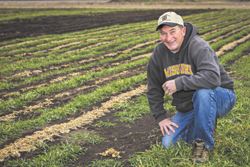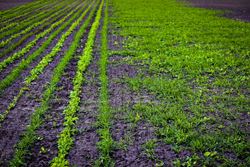Safeguarding Our Soil
Study At Hundley-Whaley Research Center Looks At The Future Of Cover Crops To Help Improve Our Soils
ALBANY, MO.
One of the next revolutions in agriculture may not be a piece of
equipment, a new crop or technology. It involves being better stewards
of the ground below our feet.
“Paying attention to the health of our soil and soil structure is
going to be key in the future,” said Bruce Burdick, superintendent of
Hundley-Whaley Research Center. “One way to really help improve our
soils is using cover crops.”
To help advance the science of cover crops, Burdick and University of
Missouri researchers have begun a multi-year cover crop study at the
research center in Albany operated by the MU College of Agriculture,
Food and Natural Resources. The research hopefully will help solve
questions on how cover crops affect the soil, help control erosion and
add a benefit to farmers.

Bruce Burdick, superintendent at
Hundley Whaley Research Center, shows off the precision agriculture
cover crop study at center in Albany. Burdick's study is looking at how
broadcast versus precision seeding of cover crops affect corn and
soybean yields. Different types of tillage systems also are being used
to see how management practices affect yields. The cover crops of
tillage radish, clover, rye and oats were planted in September.
Photo by Kyle Spradley | © 2013 - Curators of the University of Missouri
Two plots have been designated at Hundley Whaley for the study. One
will be looking at yields of corn and the other soybeans. Each plot will
be tested with innovative planting systems across different tillage
systems including strip till, no-till and reduced tillage.

Cover crops are planted at
Hundley Whaley Research Center as part of a multi-year study looking at
how different tillage systems and seeding systems effect yields of
soybeans and corn.
Photo by Bruce Burdick
A mixture of cereal rye, radish and crimson clover will be used as
cover crops with planting treatments using broadcast seeding or row
cropping with precision planting techniques.
“Our main goal is to see how the cover crop truly affects the soil
and which technique yields the best results,” said Burdick. “We already
know that cover crops help with weed and erosion control, increase soil
organic matter, improve soil structure and add carbon to the soil
profile. But we just want to be able to tell farmers what is the best
way to use these crops under a range of tillage conditions.”
A benefit of the precision planting is the farmer most likely will
not have to buy new equipment. Most planters used for commercial crops
can be easily modified for the cover crops. Burdick also believes the
row planting will help prevent denser root mats from the cover crops
that can sometimes be harder to break up when planting.
The cover crops concept is spreading, especially in Missouri where a
longer growing season in the fall means more growth of cover crops.
Another benefit of cover crops is the forage potential. Many rye
varieties can be planted to benefit a corn or soybean crop, but can be
used to feed livestock either by grazing or bailing.
Not far from Hundley-Whaley, Roger Wink of Martinsville is paying
attention to the study Burdick has initiated. For the last couple of
years he has been using cover crops on the nearly 500 acres he farms.
Wink has used triticale, a wheat/rye cross variety that has been
producing seven bales an acre in addition to helping improve his soil
structure.
“I have had some great success with using cover crops,” said Wink.
“They really help control erosion and I hardly ever see any soil loss
now. I also can tell that they do a great job to break up the soil and
put organic material back into the ground.”
Wink also planted turnips and radishes using a no-till planting system for his corn and soybean fields.
“We ate the turnips and boy were they great!” he exclaimed. “And I am pretty sure the cattle enjoyed them as well.”
He recommends anyone looking to improve their yields to look into cover crops.
“I don’t know why more folks aren’t using cover crops,” said Wink.
“We’ve farmed this land for quite a long time and now need to look at
what the future will hold for the ground we stand on.”
The multi-year project at Hundley Whaley also will be replicated in a
different soil type at the Bradford Research Center in Columbia. Funds
from a USDA NRCS Conservation Innovation Grant help support this study.∆